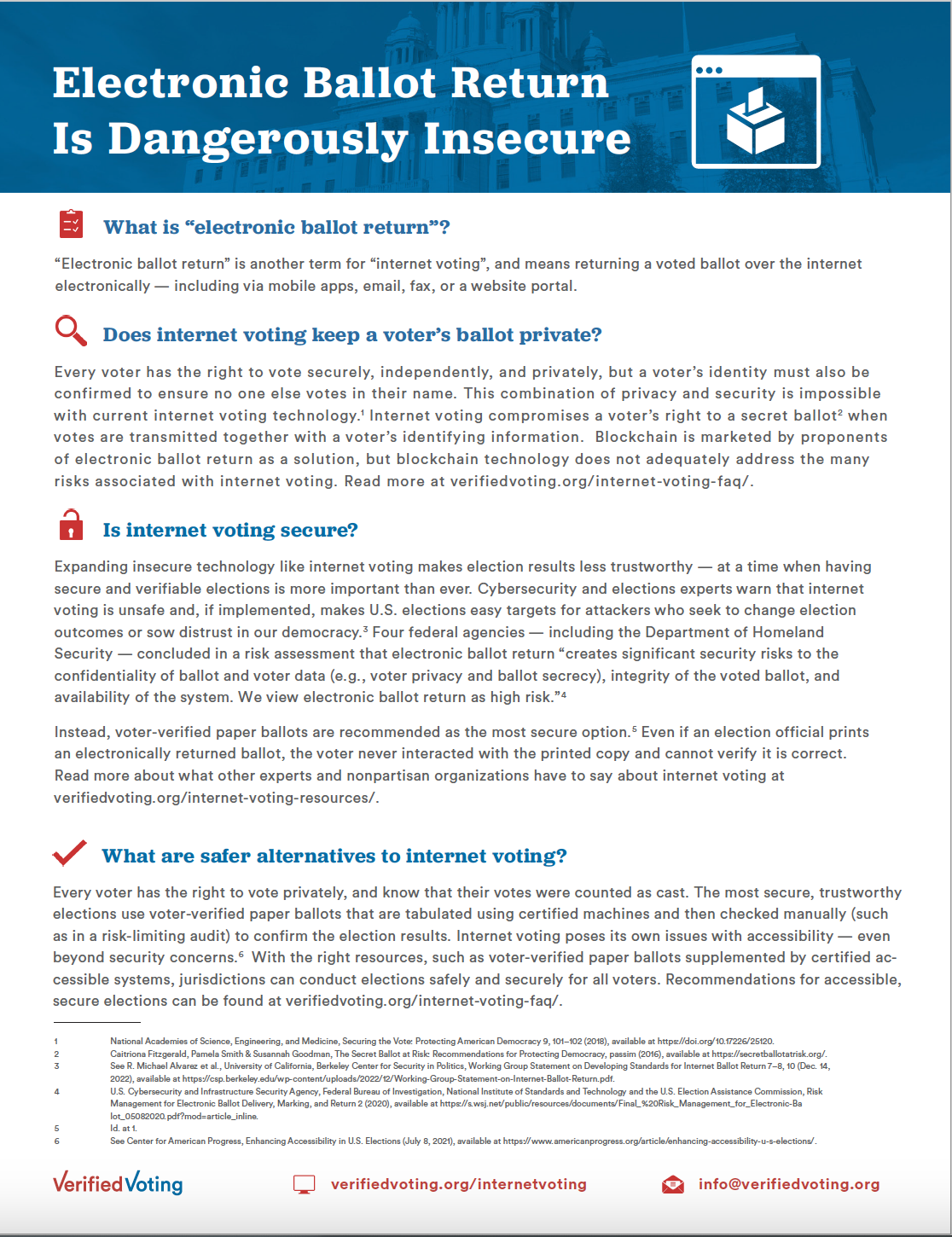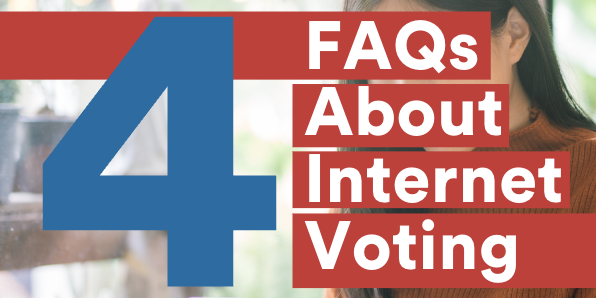
resource
Electronic Ballot Return Is Dangerously Insecure
Date: April 11, 2023
Author: Verified Voting
Issue: Internet Voting
Publication Summary
Read our downloadable one pager explaining why expanding insecure technology like internet voting makes election results less trustworthy — at a time when having secure and verifiable elections is more important than ever.
What is “electronic ballot return”?
“Electronic ballot return” is another term for “internet voting”, and means returning a voted ballot over the internet electronically — including via mobile apps, email, fax, or a website portal.
Does internet voting keep a voter’s ballot private?
Every voter has the right to vote securely, independently, and privately, but a voter’s identity must also be confirmed to ensure no one else votes in their name. This combination of privacy and security is impossible with current internet voting technology.1 Internet voting compromises a voter’s right to a secret ballot2 when votes are transmitted together with a voter’s identifying information. Blockchain is marketed by proponents of electronic ballot return as a solution, but blockchain technology does not adequately address the many risks associated with internet voting. Read more at verifiedvoting.org/internet-voting-faq/.
Is internet voting secure?
Expanding insecure technology like internet voting makes election results less trustworthy — at a time when having secure and verifiable elections is more important than ever. Cybersecurity and elections experts warn that internet voting is unsafe and, if implemented, makes U.S. elections easy targets for attackers who seek to change election outcomes or sow distrust in our democracy.3 Four federal agencies — including the Department of Homeland Security — concluded in a risk assessment that electronic ballot return “creates significant security risks to the confidentiality of ballot and voter data (e.g., voter privacy and ballot secrecy), integrity of the voted ballot, and availability of the system. We view electronic ballot return as high risk.“4
Instead, voter-verified paper ballots are recommended as the most secure option.5 Even if an election official prints an electronically returned ballot, the voter never interacted with the printed copy and cannot verify it is correct. Read more about what other experts and nonpartisan organizations have to say about internet voting at verifiedvoting.org/internet-voting-resources/.
What are safer alternatives to internet voting?
Every voter has the right to vote privately, and know that their votes were counted as cast. The most secure, trustworthy elections use voter-verified paper ballots that are tabulated using certified machines and then checked manually (such as in a risk-limiting audit) to confirm the election results. Internet voting poses its own issues with accessibility — even beyond security concerns.6 With the right resources, such as voter-verified paper ballots supplemented by certified accessible systems, jurisdictions can conduct elections safely and securely for all voters. Recommendations for accessible, secure elections can be found at verifiedvoting.org/internet-voting-faq/.
- National Academies of Science, Engineering, and Medicine, Securing the Vote: Protecting American Democracy 9, 101–102 (2018), available at https://doi.org/10.17226/25120. [↩]
- Caitriona Fitzgerald, Pamela Smith & Susannah Goodman, The Secret Ballot at Risk: Recommendations for Protecting Democracy, passim (2016), available at https://secretballotatrisk.org/. [↩]
- See R. Michael Alvarez et al., University of California, Berkeley Center for Security in Politics, Working Group Statement on Developing Standards for Internet Ballot Return 7–8, 10 (Dec. 14, 2022), available at https://csp.berkeley.edu/wp-content/uploads/2022/12/Working-Group-Statement-on-Internet-Ballot-Return.pdf. [↩]
- U.S. Cybersecurity and Infrastructure Security Agency, Federal Bureau of Investigation, National Institute of Standards and Technology and the U.S. Election Assistance Commission, Risk Management for Electronic Ballot Delivery, Marking, and Return 2 (2020), available at https://s.wsj.net/public/resources/documents/Final_%20Risk_Management_for_Electronic-Ballot_05082020.pdf?mod=article_inline. [↩]
- Id. at 1. [↩]
- See Center for American Progress, Enhancing Accessibility in U.S. Elections (July 8, 2021), available at https://www.americanprogress.org/article/enhancing-accessibility-u-s-elections/. [↩]
